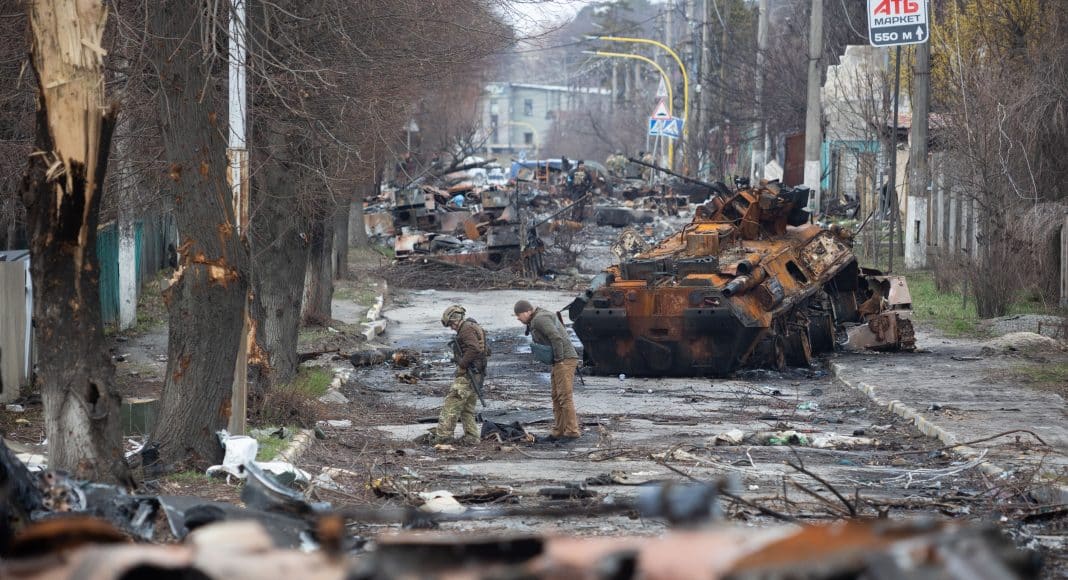24 February marks three years of NATO’s proxy war against Russia in Ukraine. Heavy casualties, massive arms expenditure, and lack of Ukrainian progress have exacerbated political tensions between its imperialist supporters. There is now a grudging consensus among the NATO imperialist powers that there will have to be a negotiated settlement, and their war efforts are increasingly focused on strengthening their eventual position at the table. US President Donald Trump’s approach reflects this aim, while his rhetoric towards Europe shows how inter-imperialist rivalry is growing. GEORGE O’CONNELL reports.
Trump had boasted during his presidential election campaign that he would end the Ukraine war ‘in 24 hours’. But on 8 January, his Russia-Ukraine envoy, General Keith Kellogg, had to reset the timescale to 100 days. But behind the usual Trump bluster, there was an indication that US imperialism would be prepared to force Ukraine to make territorial concessions to Russia.
Trump’s peace plan
The Wall Street Journal disclosed, on 7 November 2024, that a peace plan drafted by Trump’s team would postpone Ukraine’s NATO membership for at least 20 years, freeze current front lines, and create a de-militarised zone within Ukraine bordering occupied territory. Despite its wish to limit the Russian area of control, US imperialism cannot ignore the gradual advance of Russian forces in eastern Ukraine. In 2024 Russia extended the area of its military control by 4,000 sq km, seven times greater than in 2023. Almost half of this (1,800 sq km) came in the final three months of the year. For US imperialism, the risk is that a continuation of the war bolsters Russia’s position.
Whilst a withdrawal of all US military and financial aid is unlikely, Trump has called on Ukraine to lower its conscription age from 25 to 18 to bolster its army. Such a move would be politically fragile given growing domestic opposition to the war and the staggering numbers of deserters which AP News estimated on 29 November 2024 at 200,000. They are predominantly younger, leaving Ukraine’s forces with an average age of 43. Forbes reports that two brigades each of around 4,000 troops disintegrated in December 2024 before reaching the front line. Extending conscription would have to be forced by extreme Ukrainian military desperation.
Recognising its current military advantage, Russian Foreign Minister Sergei Lavrov directly rejected Trump’s proposals in a 29 December interview with Russian media outlet TASS. In recent months, President Vladimir Putin has reiterated earlier proposals from bilateral peace negotiations that took place in Istanbul between February and April 2022, immediately after the start of the war. These negotiations included a Ukrainian proposal to not join NATO and a joint agreement to exclude Crimea from the treaty, recognising de-facto Russian control.
These negotiations were dashed by Ukraine’s imperialist backers, led by US and British imperialism, on the basis that continuing the war while supporting Ukraine with a flood of arms would significantly weaken Russia. Combined with sanctions, such measures might enforce Russian regime change, and even allow a Ukrainian military victory. Now, the failure to meet these aims is forcing US imperialism to propose a settlement resembling the one on offer three years ago, possibly with even further territorial concessions to Russia. Trump’s approach to Ukraine is therefore not some drastic reversal of policy, but a response to the military situation. Behind this is the growing co-operation catalysed by the war between Russia and other states deemed hostile to Western imperialism, especially China.
European imperialist powers, especially Britain and France, are less prepared to grant concessions to Russia. They have led the various political escalations of the conflict, and have even alluded to the possibility of sending their own troops to fight in Ukraine. One among Trump’s proposals is for a European ‘peacekeeping’ force to be deployed in Ukraine post-settlement, ostensibly to safeguard Ukrainian sovereignty. The real purpose of such a force would be to ensure Ukraine remains a client state of Western imperialist powers, and is prevented from slipping into the Russian orbit. It would also protect the further penetration of Western capital into Ukraine.
The conflict between Russian and Western imperialism has a broader global dimension. Constant Western imperialist efforts to remove Russian ally President Bashar Al-Assad from power in Syria finally succeeded on 9 December 2024, thereby curbing Russian influence in the strategically important Middle East. Russia’s military bases in Syria are now under threat: on 22 January, Syrian media reported the termination of Russia’s 49-year lease for the Tartus naval harbour on Syria’s Mediterranean coast, agreed in 2017. Tartus has served as Russia’s only naval base outside the former Soviet Union, staging Russian operations into the Mediterranean and Africa; its loss would be a blow to Russia’s global pretensions.
Trump v EU
Trump has also taken aim at European imperialism with his threat to annex Greenland, an autonomous territory of EU member Denmark. On 27 January, head of the EU military committee General Robert Brieger suggested stationing EU troops in Greenland to defend it from a US incursion. Greenland contains abundant mineral resources, is a missile buffer zone between US and Russia, and offers control of new, shorter shipping routes between the Pacific and Atlantic, created by the melting ice cap. US imperialism wants to turn Greenland into a strategic bulwark against Russia and China, and sees European control as an obstacle to this aim. Without a centralised military force and much further political, economic, and military integration between EU member states, especially France and Germany, the EU will be powerless to prevent this.
FIGHT RACISM! FIGHT IMPERIALISM! 304 February/March 2025




